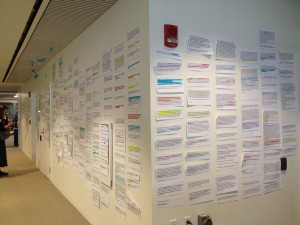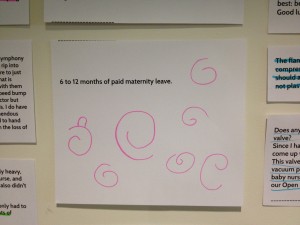Five Fixes for the Breast Pump: Our Re-Cap of the MIT Breast Pump Hackathon
Given the enormous (and well-deserved!) amount of press the MIT Breast Pump Hackathon*, you’ve probably already heard about the unlikely group that descended on the MIT Media Lab last weekend: breastfeeding moms (and supportive dads), media, manufacturers, designers, engineers, and PhDs. They came together with a common – and clever – mantra: using a breast pump sucks.
The summit was the brainchild of a team of MIT Media Lab researchers and students (who also happened to be parents), and it was borne out of their own personal frustrations as well as their drive to address an important issue in maternal and pediatric healthcare, not just here but around the world. They saw a huge opportunity to initiate and inspire innovation, as well as foster a dialogue among product designers, families, and the broader community.
They cast a wide net, bringing in moms, educators, RNs, and lactation consultants, which meant that the engineers and designers who are traditionally fixtures at a hackathon could get real time feedback from experts and consumers (some moms were even testing prototypes!).
And they used hard data (from weeSpring users!) to drive their thinking. The organizers created a huge “idea wall” with suggestions and requests from moms across the country, and the teams built DIY-style prototypes from materials provided by Lansinoh, Medela, Ameda, Simple Wishes, and other companies.
We sat in on the teams’ presentations to the judges, and found five stand-out themes.
Five Fixes for the Breast Pump
1. Bring the “quantitative self” movement to pumping.
We’re using Fitbits and other wearables to measure exercise and sleep, yet still using journals (and some very low-tech apps) to keep track of infant feeding. Learning about your letdown pattern and output per minute could help make you a more efficient and effective pumper – and make it easier to communicate with your lactation consultant or healthcare provider.
2. Replace straight suction with bio-mimicry.
Babies’ mouths don’t look or feel like hard plastic cones, so its no wonder that most women express more milk when nursing than they do in a pumping session. A few fixes emerged, including an asymmetrical flange to emulate baby’s latch and rippling effect of the tongue, using gravity from the breast to push up and pull, and a wet vac that would require lower pressure (and thus be quieter) while also reducing stress on the skin.
3. Make pumping as mobile as everything else in our lives.
Nursing moms spend up to (and sometimes more than!) two hours tethered to a heavy, noisy machine, with big plastic cones and bottles jutting out from their chests. Replacing those flanges with discrete, low-profile shields that connect to a wearable reservoir (on a belt or bag) would restore untold freedom and flexibility to women who need it more than pretty much anyone on the planet.
4. Marry old-school techniques with new innovations in technology.
Compression and massage has been scientifically proven to improve fat content and flow of milk. New technology could incorporate these time-honored techniques (and necessities for any mom suffering from mastitis) into pumping. Specific ideas here included a bra that provides hands-free massage and compression and a pump that uses suck-less compression for a low cost solution.
5. Restore a little humanity to pumping.
Let’s face it: using a machine instead of a baby to get milk out of your body is pretty dehumanizing. Yet there’s research out there that shows “mindful” pumping yields better results, so moms could have more fruitful pumping sessions if the sounds and scents of baby were part of their pumping process. Textile could serve a dual purpose by dampening the sound of the pump and picking up baby’s scent, or an app reminding you to pump could do so with photos and videos of your baby.
All in, it was an inspiring weekend, with lots of great energy and buzz, but it’s just the beginning of a long road. If you’re a nursing mom and want your voice to be heard, hop on over to weeSpring and rate your breast pump; just as we provided a ton of data to the MIT teams about what moms really want from a breast pump, we also work with companies that are developing new products (so they focus on features and functionality that really matter to parents).
*A “hackathon” is traditionally an event where computer programmers get together for a period of intense collaboration.






